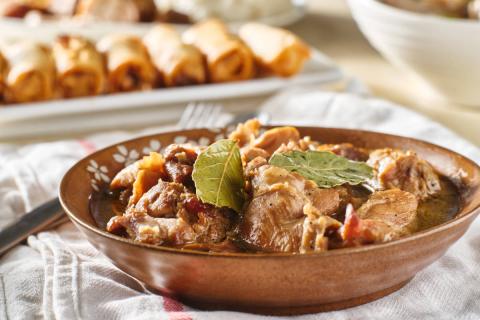
Add in the sugar and salt, then turn the heat off. Serve immediately.
Tips & tricks
The key to creating the best Filipino chicken adobo recipe is all in the marinade. The longer you can leave the chicken marinating the fuller the final taste will be. If you are really stuck for time though, it is possible to take a shortcut and cook the chicken for longer in the pan to infuse more flavour. The recipe can be varied with the addition of different chicken adobo ingredients. One popular twist is chicken adobo with pineapple, adding a sweeter element to the dish. You can also change the cuts of chicken used and for more advice on chicken cuts and how to cook them head to our helpful article here.
Another way to alter the dish is to introduce different meats or even seafood. The recipe can traditionally be made with a variety of bases from chicken to pork to mixed seafood. Discover our chilli pork adobo rice dish here for more authentic Filipino dishes and cooking inspiration.
What to serve with chicken adobo
For a flavour-filled lunchtime dish or dinner, serve chicken adobo with rice on the side. Try pouring some of the tasty sauce over the rice before serving for added depth of flavour. Other possible pairings include quinoa, spinach and, for full comfort food, mashed potatoes. Chicken adobo is a really versatile dish and can be enjoyed with a variety of sides depending on the occasion, weather and time of year.
Origins of the recipe
Adobo is derived from the Spanish word ‘adobar’ which means ‘to marinate’ but it is actually a famous Filipino dish. It’s said to have received its name when the Spanish conquerors invaded in the 16th Century and, upon viewing the Filipino traditional cooking methods, labelled the dish ‘adobo.’ The word ‘adobo’ refers to the process of marinating meat, seafood or vegetables in a mix of soy sauce and vinegar. The balance of the vinegar with the soy sauce provides the sweet and salty base that the dish is known for.
Another important factor in the use of vinegar was preservation. Vinegar was traditionally used to keep food fresher for longer before the introduction of fridges and freezers, especially in hotter climates where food was prone to spoilage much faster. The recipe is thought to have been first recorded as early as the 1600s and would likely have been originally cooked in clay pots. Today it’s still known as the Filipino national dish and has remained a firm favourite in houses in the Philippines and beyond. Find out more about the history of Filipino cooking and cuisine here.
Storage
Any leftovers should be stored in the fridge for around 4-5 days, but it is possible to freeze the dish too. Sometimes it tastes even better after a day in the fridge as the flavours are given more time to infuse into the meat!


